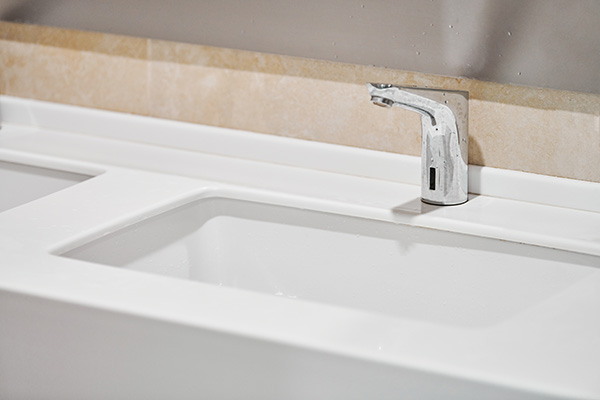
Helping Hands-free
February 24, 2021 | By Steve Goldie
The pandemic has placed more attention on touchless plumbing fixtures in both public spaces and at home.

Getty Images
“Out of adversity comes opportunity.”
– Benjamin Franklin
Well I think few, if any of us, would dispute that 2020 was a year of adversity; “good riddance” or some similar phrase was perhaps the most common tweet, text or phone message this past New Year’s. Sadly, the challenges of the pandemic did not cease as the year ended, and we can be sure that 2021 will also see its share of adversity. And if we are to believe old Ben Franklin, opportunity also awaits.
Let’s look at one opportunity that may seem obvious in the midst of the worst pandemic the world has seen since the 1918 Spanish influenza outbreak: touchless plumbing fixtures.
List of benefits
Touchless plumbing fixtures are not new; they have been with us since the 1950’s. Originally appearing in medical institutions, where eliminating the need to touch a fixture to operate it had obvious and potentially life saving benefits. Reducing the spread of germs and viruses is not a benefit that is exclusive to medical facilities however, and by the 1990’s motion detecting, sensor operated fixtures were becoming widely used in many public washrooms.
Not only did they become more widely used, but they became more varied. In addition to touchless faucets and flush valves, we now see touchless towel dispensers, soap dispensers, hand dryers and showers in communal gym and pool change rooms.
Sanitary and health advantages have not been the only benefit driving the development and widespread adoption of touchless fixtures. Touchless faucets and flush valves use far less water making them a good choice for the ever-growing environmentally conscious and aware demographic.
Less touching means reduced wear and tear, requiring less maintenance. This results in a longer life cycle and further savings in operational costs.
User convenience is also a factor. Fixtures that do not require hands to operate means those hands are free to hold onto shopping bags and personal items that most of us really don’t want to put down anywhere in a public washroom. Small children also benefit from the ease of use, as do those who struggle with arthritis or mobility issues. Studies show that when it is easier and quicker to do so, more people are inclined to wash their hands.
When you consider all of the benefits it is not difficult to see why the touchless fixture market has seen steady growth. One major manufacturer reports this segment had been growing at a steady pace of 20% annually since 2018, and with the arrival of COVID-19, sales have jumped over 100%.
An acquaintance of mine, a successful general contractor in the GTA, recently started a new company to meet the demand to retrofit commercial bathrooms with touchless fixtures. He saw an opportunity and came up with a plan to capitalize on it.
Right at home
Although the vast majority of touchless fixtures are used in commercial applications and public spaces, opportunities are growing in the residential market. Pretty much every manufacturer seems to be introducing or expanding touchless offerings targeted for homes.
It makes sense when you think about it since the benefits in commercial applications still apply to residential use. The water savings, particularly when shaving and brushing teeth, are one example, and I would definitely appreciate a hands-free kitchen faucet when preparing dinner and my hands have been handling raw beef or chicken.
Psychologically most of us probably still feel germs in public are somehow more contagious than “our own” germs, but contact transfer can occur just as easily in our own homes.
One poll in the U.S. recently reported that 85% of Americans said they are “more interested than ever” in touchless bathroom products with most indicating hands-free fixtures would be essential components of future upgrades. The industry clearly expects the trend towards touchless fixtures will continue, as is evidenced by the breadth of products available.
Evolving technology
The touchless product offering is not just getting larger and more diverse; it is also much more sophisticated and reliable than some earlier versions. I am sure most of us have experienced the frustration of standing in front of a sink in a public washroom, waving our hands at every possible angle, finally giving up and walking away only to have the water turn on as we turn away.
Today’s touchless fixtures still use the same motion or proximity sensors, but either the sensors are more accurate or the manufacturers have learned how to better apply them.
Not only are they more reliable, but they do more than just turn a faucet on and off, there is technology that can adjust water temperature and flow without touching any part of the faucet. I expect we will see voice activated features and WiFi connectivity, a completely overused and unnecessary addition in my opinion, but that’s a rant for another day.
I am not sure what old Ben Franklin might have thought of these things, but I have to agree with his belief that opportunities can be born out of times of adversity. We are all seeing more than our share of adversity these days, so let’s also look for the opportunities. Let us especially look for opportunities to work together, to cooperate and make this world a safer more hospitable place.

 Steve Goldie learned his trade from his father while working as a plumber in the family business. After 21 years in the field, he joined the wholesale side of the business in 2002. His expertise is frequently called on to troubleshoot and advise contractors. Find him at sgoldie@nextsupply.ca.
Steve Goldie learned his trade from his father while working as a plumber in the family business. After 21 years in the field, he joined the wholesale side of the business in 2002. His expertise is frequently called on to troubleshoot and advise contractors. Find him at sgoldie@nextsupply.ca.


